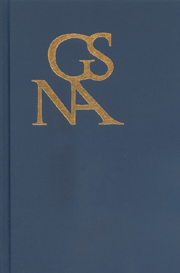Book contents
- Frontmatter
- Contents
- Presidential Address (December, 2004) Schiller vs. Goethe: Revisiting the Conflicting Reception Vectors of Heinrich Heine, Ludwig Börne, and Wolfgang Menzel
- Goethe's Mixed Media: The Entertainers in Jahrmarktsfest zu Plundersweilern
- Goethe's “Ilmenau” and the Origins of the Aesthetic State
- Familial Politics and Political Families: Consent, Critique, and the Fraternal Social Contract in Schiller's Die Räuber
- Paintings in Goethe's Wilhelm Meister Novels: The Dynamics of Erecting and “Eroding” the Paternal Law
- “Waldplatz,” “Wahlplatz”: Miszelle zur Golgatha-Konnotation einer Episode in Wilhelm Meisters Lehrjahre
- Shocks from a Sicilian Underworld: Gangi,“Gänge,” and a New Source for the “Mütter” in Goethe's Faust
- “Feuer brennen blau”: Rethinking the Rainbow in Goethe's Faust
- Cosmopolitanism and Weltliteratur
- “Von jedem öffentlichen Wirken in Deutschland ausgeschloßen”: Ein Brief Ottilie von Goethes an Sarah Austin (4. Aug. 1840)
- Book Reviews
Goethe's “Ilmenau” and the Origins of the Aesthetic State
Published online by Cambridge University Press: 05 February 2013
- Frontmatter
- Contents
- Presidential Address (December, 2004) Schiller vs. Goethe: Revisiting the Conflicting Reception Vectors of Heinrich Heine, Ludwig Börne, and Wolfgang Menzel
- Goethe's Mixed Media: The Entertainers in Jahrmarktsfest zu Plundersweilern
- Goethe's “Ilmenau” and the Origins of the Aesthetic State
- Familial Politics and Political Families: Consent, Critique, and the Fraternal Social Contract in Schiller's Die Räuber
- Paintings in Goethe's Wilhelm Meister Novels: The Dynamics of Erecting and “Eroding” the Paternal Law
- “Waldplatz,” “Wahlplatz”: Miszelle zur Golgatha-Konnotation einer Episode in Wilhelm Meisters Lehrjahre
- Shocks from a Sicilian Underworld: Gangi,“Gänge,” and a New Source for the “Mütter” in Goethe's Faust
- “Feuer brennen blau”: Rethinking the Rainbow in Goethe's Faust
- Cosmopolitanism and Weltliteratur
- “Von jedem öffentlichen Wirken in Deutschland ausgeschloßen”: Ein Brief Ottilie von Goethes an Sarah Austin (4. Aug. 1840)
- Book Reviews
Summary
GOETHE'S 1775 DECISION to move to Weimar met with skepticism on all sides. Father Johann Caspar Goethe was openly hostile to his son's attachment to the insignificant statelet and its inexperienced duke, and peers wondered why the erstwhile champion of titanic individualism, the affluent citizen of a free imperial city, would willingly subject himself to the constraints of life as a court poet. Many believed that his artistic career was over, and the marked decline in literary activity that characterized his first ten years in the duchy seemed to confirm their suspicions. Goethe was far from inactive during this period, but progress on major projects faltered. After finishing the prose version of Iphigenia in 1779 and a satirical adaptation of Aristophanes' The Birds in 1780, he failed to complete any literary work of length for five years. Confronted with both the reduction in volume and the shift in the nature of the works produced during these years, scholars have often viewed them as a kind of latency period that comes to an end only with Goethe's 1786 departure for Italy and his equally decisive engagement with the French Revolution.
The works that were produced during this period, however, deserve closer attention. No one would deny the impact of Italy and the Revolution on Goethe's artistic and intellectual development, but crucial aspects of his later thought, especially as regards the relationship between art and politics, were already taking shape in response to the challenges of this first Weimar decade.
- Type
- Chapter
- Information
- Goethe Yearbook 13 , pp. 53 - 74Publisher: Boydell & BrewerPrint publication year: 2005



